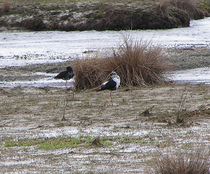New Zealand Stilt
Despite of 20 years of intensive protection, this species remains the rarest wading bird in the world. and the current population is estimated at 22 adult birds. There is a captive population of some 25 adults, annual release in the wild of captive-bred birds and predator control has probably prevented it from becoming extinct in the wild. During the breeding season it is restricted to the upper Waitaki Valley in the South Island. Small numbers overwinter in the North Island.
The New Zealand Stilt is classified as Critically Endangered (CR), facing an extremely high risk of extinction in the wild.
New Zealand Stilt in Tasmania. Stilt 15:37.115 Clarence St., Bellerive, Tasm. 7018, Australia. HEWISH, M. 1989 Hooded Plovers, Pied Oystercatchers and a windy week- end at Discovery Bay, Victoria. Stilt 15:24-25. 74 Wellington St., Bacchus Marsh, Vic. 334, Australia. HOLNESS, P.R., WARREN, B.C.H., CREASE, Capt. AJ. & KERSLEY, R. 1989 The Stone Curlew on MoD Lands. The Adjutant 19:55-60. More
Black / New Zealand stilt {Himantopus novaezelandiae} ringed juvenile roosting in the rain, Lake Pukaki, South Island, New Zealand, January. Critically endangered 01236615 Black / New Zealand stilt {Himantopus novaezelandiae} ringed juvenile roosting in the rain, Lake Pukaki, South Island, New Zealand, January. Critically endangered Black / New Zealand stilt {Himantopus novaezelandiae} juvenile sheltering behind tussock, Lake Pukaki, Canterbury, South Island, New Zealand. January. More
stilt, the black-tailed stilt, the New Zealand stilt, the American avocet, the Andean avocet, the pied avocet and the red-necked avocet. Endangered in NH Endangered in N.H. Threatened in NH Threatened in N.H. introduced Introduced Endangered in the US Endangered in U.S. Threatened in the US Threatened in U.S. breeds in NH Breeds in N.H. More

Original source: Arthur Chapman
Author: Arthur Chapman
Permission: Some rights reserved
Family : Recurvirostridae
Genus : Himantopus
Species : novaezelandiae
Authority : Gould, 1841

